► Premium crossover triple test
► XC90 vs X5 vs Range Sport
► Who makes the plushest SUV?
They say the devil is in the details. Although, as is common with such matters, it appears that God got there first. The original phrase wasn’t a warning against trickery akin to the Prince of Darkness, but a sort of religious encouragement that you should always do your best. God is in the detail, see. While it seems unlikely that any of this has anything to with Norse mythology, that Volvo elected to name the new XC90’s daytime running light signature ‘Thor’s Hammer’ is nonetheless a detail I rather like. And is but one instance of the sheer attention to minutiae that has clearly been lavished on this very modern interpretation of the SUV. That not all of these intricacies are entirely beneficial just goes to prove the wisdom of whoever came up with the opening sentiment.
The stakes are particularly high because the new XC90 is not only the follow-up to an SUV so well received it was still selling strongly when death finally reconfigured the production line 12 years after its original launch, but also quite literally the embodiment of new Volvo, the first fruit of the firm’s own Chinese-backed labours since being freed from the chattels of Ford. That handsome face, punctuated by an illuminated double-homage to a divine smack-down tool and a more prominent version of the ‘iron mark’ logo, will soon be appearing across an entirely new range of Volvos, all based on the brand spanking Scalable Product Architecture (SPA) that debuts beneath the XC90’s steely visage. This every-which-way-resizable platform is the major output of an $11bn investment programme, and comes packaged with stellar safety equipment and an interior rethink centred around a tablet-like touchscreen infotainment unit. In isolation, the new XC90 felt pretty hopeful; can the likely best-selling D5 turbodiesel engine bring the hammer down on a pair of key rivals?
Those rivals are the BMW X5 xDrive 25d and the Range Rover Sport SDV6 – chosen partly because they can both match the XC90’s seven-seater accommodation (albeit via the options list), and partly because they both set standards for quality, lavishness and driving engagement that are at any given moment in danger of being labelled as benchmarks. Distinct image associations, too. With big talk of uniquely Scandinavian design heritage, ‘true driving pleasure’ and ‘handcrafted’ finishing touches – not to mention cranking up the price – Volvo isn’t shying away from this kind of confrontation. That the previous XC90 was closely associated with yummy mummies on the public-school run provides a refreshing counterpoint to the overtly macho posturing typically allied with the other two, and if anything the broad strokes of the new XC90’s exterior speak even more of a machine optimised for the safe urban transit of precious junior cargo. It certainly doesn’t look as if it’s about to go crashing about in the countryside. Owners won’t. And we aren’t.

Instead we’re in Henley, and will later be heading over to Marlow, following a route that will take us out onto fast dual-carriageways and along narrow, winding B-roads, having already covered motorways to get here. The closest we’ll come to a green lane is a gravel-topped scenic parking spot, judging this about as far off-road as most buyers will ever take these monsters. The ability to comfortably and confidently negotiate a high street choked with somnambulant shoppers and errant delivery drivers is a better test of this type of mettle (or metal) these days, for this has become their reality. Besides, if you do want to go crushing nature, the verdict is simple: buy the Range Rover Sport. Neither rival offers any pretence of such aptitude; being loaded to the gunwales with super-articulating axles and off-road electronics is one of the reasons the Range Sport is more expensive.
All three look perfectly at home parked outside the Henley rowing museum. But the BMW X5 is easily the least… obvious. As with the Volvo, this example is propelled by a modest 2.0-litre turbodiesel, and with 215bhp is the least powerful vehicle in the test. Even with the body addenda included with the increasingly default M Sport trim level it seems somehow demur – despite being bigger in every dimension than its squat and muscular predecessor it appears much less arrogant and self-aggrandising. It’s almost as if this 4×4 is trying to apologise for itself; the 19in alloys look undersized, and it has by far the most discernible and technical aerodynamic elements. You can see daylight through both sides of the front wheelarches, as the engineers have sought to create Air Cushions and use Air Breathers (the vents behind the front wheels) to minimise its physical disruption of the environment. It’s at once dull and highly considered, with little to draw you in after a cursory glance, a theme that continues on the inside with an interior so typically BMW you lose interest almost as soon as you’ve registered it. Amazing that a car this large can be trying so hard not to be noticed.
The Range Rover Sport: a little bit bling
Attempted invisibility is not an accusation anyone is likely to aim at the Range Rover Sport. Representing the breed on this occasion is CAR’s own long-termer, which means it has the smallest engine currently on offer – a 3.0-litre V6 turbodiesel, nevertheless 50% greater in capacity than anything available in the Volvo – and HSE Dynamic specification. This middle-ranking trim takes the necessary stockpile of funds even further from the other two but means this Range, which at 2115kg remains the heaviest of our trio in spite of its aluminium construction, comes equipped with the Dynamic Response active anti-roll-bar system, the better to test the XC90’s ‘driving pleasure’ claim. That our car also looks as if it’s been specced by someone with ‘seek counselling’-grade Columbian pharmaceutical distribution fantasies does little to alleviate the sensation that you’re driving something many people despise. You’re immediately the villain in one of these.
It’s lucky the windows are tinted, not least because it’s more difficult for animal rights protestors to see the crimes against bovinity inside. Stirring though it is to climb up – noticeably more so than in the others – into a cabin so swathed in leather you can’t help thinking of steak dinners, this is a type of luxury that feels rather old-school to me. There’s no doubting the base quality: the real metal is cool to the touch, the hide soft and inviting, and there’s an impressively befuddling array of Terrain Response options to choose from. Yet the more everyday technology is outmoded and under-thought. The central touchscreen is the smallest on test, has a cluttered homescreen, features the world’s ugliest mapping software and is angled to such an unfortunate degree that unshading the optional panoramic glass roof renders it unusable on sunny days due to the glare. The equally optional multi-view external camera system is also exciting in principle, but the optical hardware is in desperate need of an upgrade – the clarity and resolution of the X5’s (equally optional) reversing camera makes the system seem as sharp as recordings of the moon landings.
No doubt the country club ambience of the Range Rover Sport has plenty of appeal to plenty of punters, but the Volvo still throws it into relief. Inside this XC90 all is light and airy, with a colour palette dominated by blonde wood veneers and ever-paler shades of grey, oh so much space, and the sleek 12.3in portrait-format touchscreen interface sitting almost entirely alone in the middle of the dashboard. There is no cleaner interior design this side of a Tesla, and you approach the XC90 eager to find out if a mainstream manufacturer can possibly have grasped such a contemporary, minimalist concept with anywhere near the same degree of success. More fuel to that fire comes when you learn CAR’s own elder statesman, Gavin Green, has described the XC90’s cabin as the finest this side of a Rolls-Royce or Bentley.
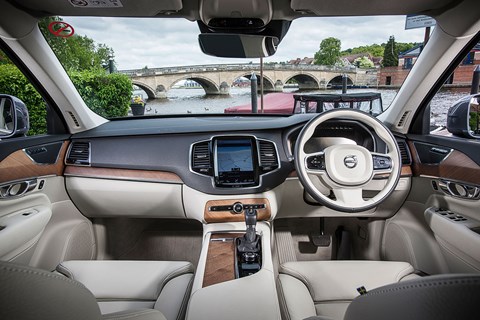
I’m not so convinced. Perhaps it’s because this car is in entry-level Momentum rather than highfalutin Inscription specification, but there’s almost immediately a sense that the quality goes little deeper than those fancy veneers. The ‘diamond-cut’ control knobs for the stereo volume and the starter switch seem a touch flimsy in this company, and while the reaction to reduce the number of buttons is highly commendable (the pre-SPA generation of Volvos surely used up the firm’s quota for this century anyway), demoting almost every interior function to touchscreen remains a contentious decision. Adjusting the climate control, for example, has been thoroughly considered – you rarely need more than one stab at the relevant screen real estate – but still requires your eyes to linger longer away from the road than traditional solutions. Other elements of the interface suggest the engineers didn’t quite know what to do with the system once they’d come up with it. The digital ‘buttons’ are big and clear, and you can swipe and pinch and scroll very easily, yet you can’t always get to the information you’re after. With a screen this large and an interface this clever, why doesn’t there seem to be an obvious way to display the ‘now playing’ information from the digital radio, for instance? In daily use, unresolved details like this become disproportionately irritating; to be fair, the Range Rover doesn’t do a great job of this sort of thing either.
Irritating is also an appropriate word for the Volvo’s ride. This is the first new XC90 that we’ve driven on the standard steel-sprung suspension – all-round electronically controlled air suspension is a £2150 extra – and it’s fidgety and thumpy in a manner that again suggests a lack of true depth beneath the shiny surface. It doesn’t thunk into potholes so much as twang, and although the initial turn-in is keen, the resulting body roll doesn’t quite keep up that opening promise. Still, the light steering seems to suit the new-age character of the rest of the car, and it doesn’t want for actual accuracy. Widest of the three, the XC90 is effortlessly positioned, doesn’t make you nervous when facing on-coming country lane traffic, and – aside from the ride – excels around town. As the least heavy (‘lightest’ seems inapt for a two-tonne behemoth) it delivers determined progress via its 222bhp, but you do miss the revvy zing of the less powerful BMW and the laid-back muscle of the bigger-lunged Range Sport. And occasionally curse the lack of standard-fit paddleshifters.
Where the Volvo – and exceptionally the BMW – will do the magic trick of shrinking around you, the Range Rover Sport never feels anything less than flinch-inducingly enormous. Despite that larger engine, the seriously clever chassis tech and standard air suspension which provides an extremely assured ride (if not a flawless one, given the optional 22s), it is strangely ponderous in many circumstances. The long-travel throttle pedal demands a determined prod when pulling away from standstill that somehow defies finesse, and being seated so obviously higher than in the others only conspires to make you overly conscious of its width and more prone to rolling sensations – though in fact the body control is very good, as is the fluidity of the steering. There’s also no denying how safe and secure you feel, lording it over everybody. Which, given the Range Rover is way behind the others in terms of active safety aids, is perhaps ironic; you’ll be doing your own pedestrian detection here.
The BMW X5: a slick drive
So what of the X5? It has none of the others’ visual flash inside or out, subconsciously dismissing it into third place until you finally get in and start using it. The engine is the sweetest of the lot – and that’s ahead of an upgrade to a new 228bhp ‘modular cylinder’ unit later this year – belying its small size with the assistance of BMW’s Sport variant of the eight-speed ZF gearbox, a version of which is also fitted in the Range (the Volvo uses an Aisin Warner ’box). BMW makes the gearbox work that bit better, the snappier paddle-actuated downchanges a case in point, especially when you’re weapons hot on approach to a roundabout. Such tomfoolery also immediately fortifies your X5-buying decision to downsize from a six-cylinder anvil – the four-pot X5 isn’t as instantly keen to change direction as the XC90 but is much more convincing once you’re committed to the turn. Neither competitor can match the poise of the M Sport trim’s standard Adaptive M suspension, which combines continuously variable damping with self-levelling air springs at the rear. The resulting ride in Normal isn’t so much firm as authoritative, the subframes seemingly superbly isolated from the body structure; it never irritates in the manner of the Volvo because it’s ace in the corners – the Sport settings only extend this agility. Wind it up, and this 2040kg heavyweight flies.
There’s more to the X5 than driving, though. The interior may be the most predictable and least ocularly arresting, but my goodness it works well. The highly evolved iDrive and the user-configurable buttons on the centre console are reason enough for enduring long-term satisfaction; the first time you see detailed lane-guidance navigation appear in the vast head-up display you’ll know it’s love. Okay, the HUD is a £995 option (Volvo’s alternative – not tested – costs £1000), but the latest iteration’s ability to project telephone contact lists and infotainment data directly into your field of view tells you BMW’s got the whole human/machine interface immensely sussed. What’s more, available safety kit isn’t far off Volvo levels – beyond it when it comes to Night Vision technology – and there isn’t a single aspect of the internal build quality that makes you go urgh. The X5 also retains a split tailgate, making it the only contender to give you somewhere to sit while changing your wellies.
Verdict
In the end, each of these SUVs could justify top billing, and any one might prove the perfect solution for your particular circumstances. The new XC90 is smart, clean-cut and ultra-modern – and while neither rival is short on interior space, it’s the Volvo that’s truly cavernous, up to and including the standard third-row seating designed for 1.7m tall adults, not just children. The Range Rover Sport has the image, and the pizazz, and the astonishing multi-terrain proficiency – and you will never feel short-changed by its appropriately weighty showroom value. In this company, the BMW is the least outright desirable, but with the thoughtful excoriation of its previously heavy-handed physical presence, the brilliant user-friendliness of its cockpit, and the fantastic togetherness of its driving experience, it doesn’t half sneak up on you. It might not be cool, but as the most complete package the X5 entirely deserves the overall honours.
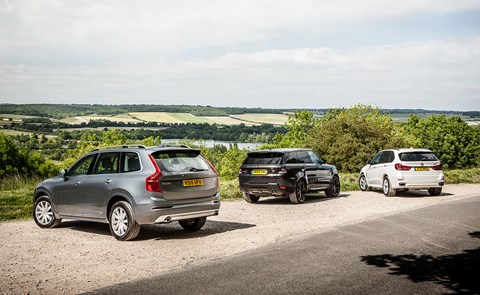
Read on for CAR magazine’s technical spec analysis of the three premium SUVs.
Key tech: Volvo XC90 safety
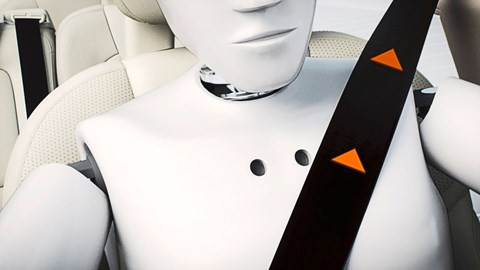
Volvo’s obsession with safety reaches new heights in the XC90. Not only will it spot pedestrians and cyclists, it displays speed limits so prominently it’s surely only a matter of time before it starts issuing its own Fixed Penalty Notices. Two new systems also feature: a ‘run-off road protection package’ and ‘intersection auto brake’. The former detects if you’ve left the tarmac and are about to plummet into the scenery, tightening the belts. The latter applies the brakes if it thinks you’re about to pull out in front of on-coming traffic.
Key tech: BMW X5 man vs machine
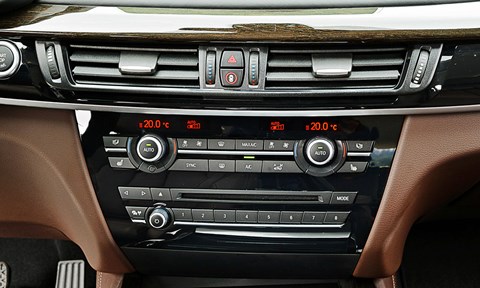
That BMW still doesn’t offer a touchscreen (and won’t until the new 7-series) seems wildly anachronistic, yet iDrive is now so easy to use you never miss it – just twirl, nudge and click the rotary controller without even glancing down. The numbered buttons above this on the centre stack aren’t just for radio stations, they can be programmed with in-car instructions, including nav destinations, while a simple rocker switch accesses the different drive modes (from EcoPro to Sport+). But it’s the £995 full-colour head-up display that really steals the show. Together: what a combo!
Key tech: Range Rover Sport – ‘Let’s off-road!’
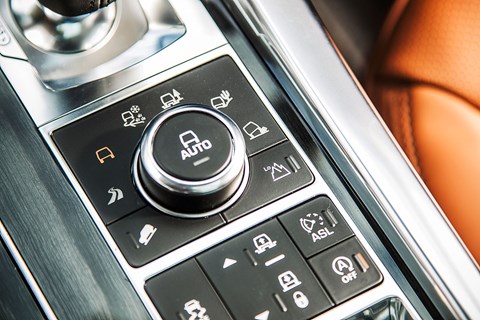
If you want to go off-roading you want the Range Rover. 260mm front and 272mm rear wheel travel – easily best in class – deliver 546mm of total wheel articulation. Standard air suspension now offers ground clearance of up to 278mm (up 51mm) and a 185mm range of adjustment. At the same time a new Dynamic Response setting counteracts body roll on the road; together with torque vectoring and an active rear locking diff it’s impressive on the way to the swamp, not just wading through it (up to depths of 850mm).